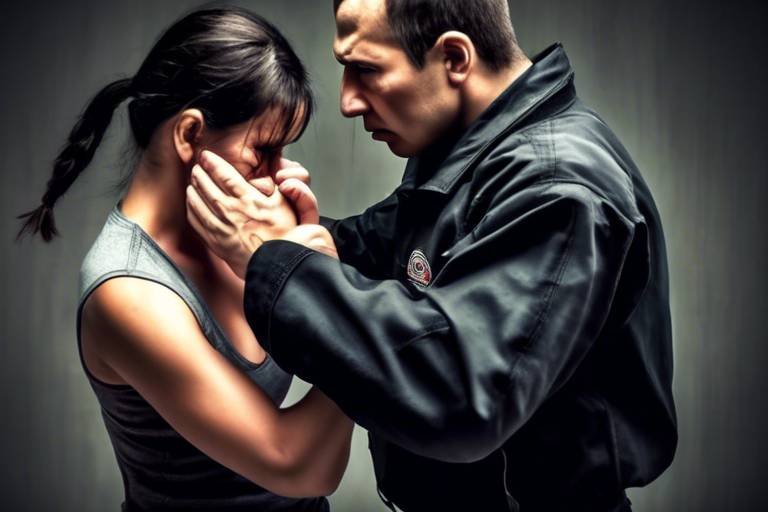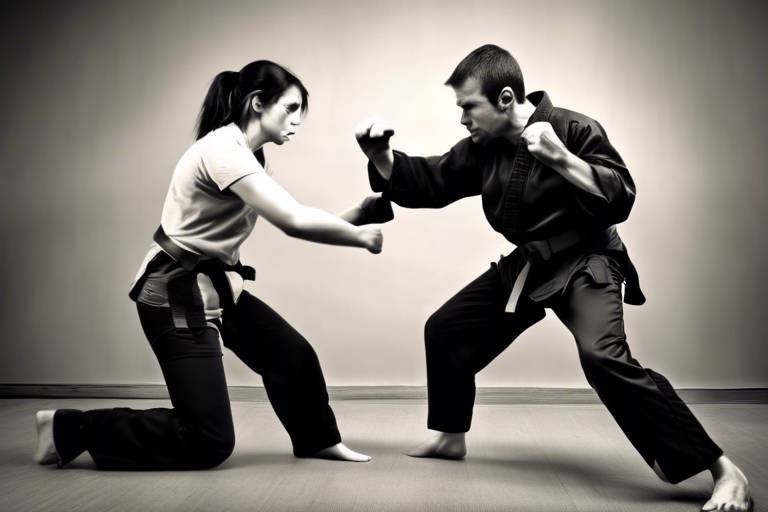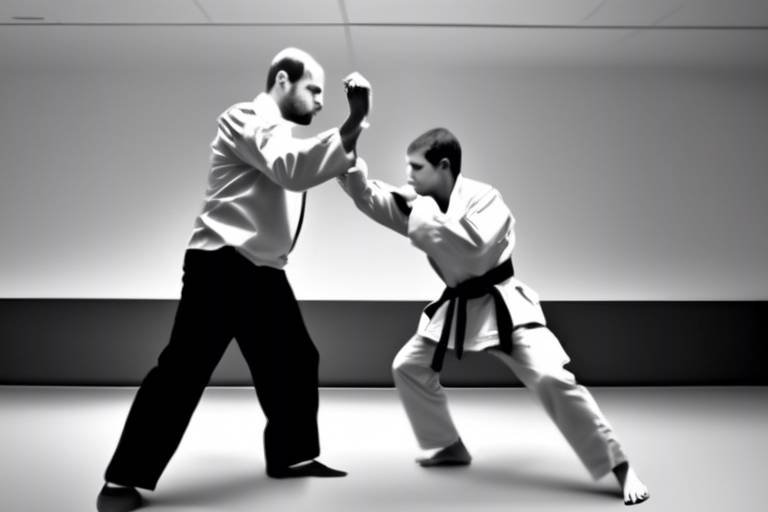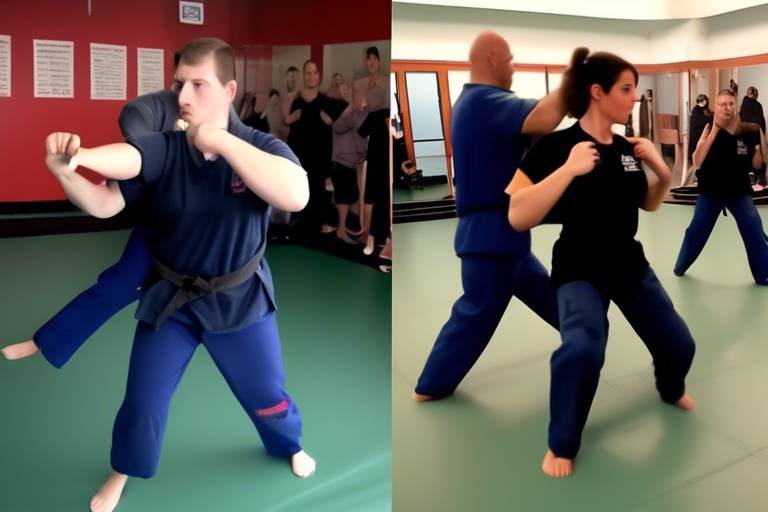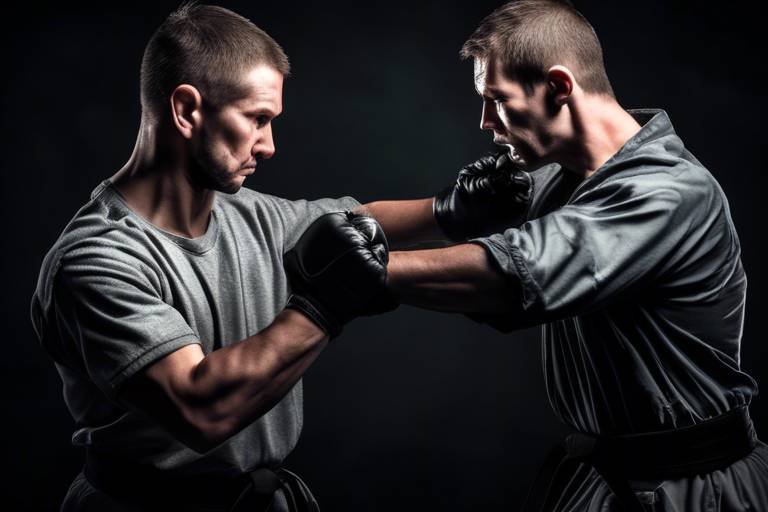Effectiveness of Kickboxing as a Self-Defense Technique
Kickboxing is not just a sport; it’s a powerful self-defense technique that can transform anyone into a more confident and capable individual. Imagine being able to defend yourself in a tough situation, all while getting fit and having fun! The effectiveness of kickboxing lies in its combination of physical prowess and mental fortitude. In today’s world, where personal safety is paramount, mastering kickboxing can be a game-changer. It equips individuals with the skills to handle confrontations, enhances their physical abilities, and instills a sense of empowerment that is hard to match.
One of the most appealing aspects of kickboxing is its comprehensive approach to fitness. It’s not just about throwing punches and kicks; it’s a full-body workout that builds strength, improves flexibility, and boosts cardiovascular health. When you engage in kickboxing, you’re not only preparing your body to defend itself but also enhancing your overall fitness level. This is crucial because a physically fit person can react faster, move with agility, and endure longer in high-pressure situations. So, whether you’re looking to get fit or learn how to protect yourself, kickboxing has got you covered!
Moreover, kickboxing is about more than just physical training; it’s a journey towards mental empowerment. Picture yourself walking down the street, feeling confident and aware of your surroundings. This is the kind of mindset kickboxing cultivates. It helps individuals develop a strong mental framework that is essential for navigating confrontational situations. The training doesn’t just prepare you physically; it also sharpens your mental acuity, enabling you to make quick decisions when it matters most. In a world where split-second choices can make all the difference, this mental edge is invaluable.
Let’s not forget the fantastic stress relief that comes with kickboxing. After a long day, what could be better than kicking and punching away your worries? Kickboxing provides an outlet for pent-up energy and stress, allowing practitioners to channel these feelings into something productive. This positive energy release not only improves mood but also enhances focus and discipline, both vital traits in self-defense scenarios. When you train your body, you also train your mind to stay calm and collected, which is crucial when facing potential threats.
In addition to stress relief, kickboxing significantly enhances concentration skills. As you train, you become more aware of your surroundings and learn to read situations better. This heightened situational awareness is a critical component of self-defense. It’s not just about knowing how to strike; it’s about recognizing potential dangers before they escalate. Kickboxing teaches you to assess your environment quickly and react accordingly, ensuring you’re always one step ahead.
Furthermore, emotional regulation is another significant benefit of kickboxing. In high-pressure situations, anxiety and fear can cloud your judgment. However, through consistent practice, kickboxing helps individuals manage these emotions effectively, allowing them to stay focused and composed. This emotional resilience is essential when faced with real-life confrontations, as it enables you to act decisively rather than freeze in fear.
Ultimately, kickboxing teaches practical self-defense techniques that are directly applicable in real-life situations. From effective striking skills to defensive maneuvers, the training you receive in kickboxing can be a lifesaver. It’s not just about learning how to throw a punch; it’s about understanding how to protect yourself while also being prepared to counterattack when necessary. In essence, kickboxing equips you with a valuable skill set that enhances personal safety and boosts confidence.
Kickboxing encompasses a variety of techniques designed specifically for self-defense. The striking techniques, like jabs, hooks, and roundhouse kicks, are essential for creating distance between you and an attacker. These moves not only incapacitate an opponent but also allow you to escape potentially dangerous situations. Moreover, defensive maneuvers, such as blocking and evading strikes, are equally important. They enable you to protect yourself while maintaining the ability to counterattack when the moment is right.
- Is kickboxing suitable for beginners? Absolutely! Kickboxing classes cater to all skill levels, making it accessible for beginners.
- Can kickboxing really help with self-defense? Yes! The techniques learned in kickboxing are practical and can be applied in real-life situations.
- How often should I train to see results? Consistency is key! Training 2-3 times a week can lead to noticeable improvements in fitness and self-defense skills.
- Do I need any special equipment to start kickboxing? Basic gear includes hand wraps and gloves, but many gyms provide equipment for beginners.

Physical Benefits of Kickboxing
This article explores the advantages of kickboxing for self-defense, including its physical benefits, mental empowerment, and practical techniques that can be applied in real-life situations.
Kickboxing is not just a sport; it's a full-body workout that offers a plethora of physical benefits. Imagine stepping into a ring and feeling the rush of adrenaline as you throw punches and kicks. This engaging activity does wonders for your body, enhancing your strength, flexibility, and cardiovascular health. With every jab and roundhouse kick, you’re not only learning to defend yourself but also sculpting your physique.
One of the key benefits of kickboxing is its ability to improve overall strength. The dynamic movements involved in kickboxing require the use of multiple muscle groups simultaneously, which results in a comprehensive workout that builds muscle tone and endurance. Whether you’re throwing a powerful uppercut or executing a swift kick, you’re engaging your core, legs, and arms in a way that traditional workouts might not.
Flexibility is another significant advantage. As you practice various kicks and stretches, you’ll find your range of motion increasing. This is crucial not only for kickboxing but also for preventing injuries in daily life. Think of it as oiling the hinges of a door; the more you practice, the smoother and more efficient your movements become.
Moreover, kickboxing is a fantastic way to boost your cardiovascular health. The high-intensity nature of kickboxing workouts elevates your heart rate, making it an excellent form of cardiovascular exercise. Studies have shown that engaging in such high-energy activities can lead to improved heart health, increased lung capacity, and better overall stamina. In essence, kickboxing transforms your body into a well-oiled machine, ready to handle whatever life throws your way.
To give you a clearer picture of these benefits, here’s a quick overview:
| Benefit | Description |
|---|---|
| Strength | Enhances muscle tone and endurance through dynamic movements. |
| Flexibility | Improves range of motion and reduces the risk of injury. |
| Cardiovascular Health | Boosts heart health and increases lung capacity. |
In conclusion, kickboxing is more than just a means of self-defense; it’s a holistic approach to fitness that empowers individuals physically and mentally. The combination of strength training, flexibility exercises, and cardiovascular conditioning creates a well-rounded workout that prepares you for both the ring and real-life confrontations. So, if you’re looking for a fun and effective way to get fit while learning how to defend yourself, kickboxing might just be the perfect choice for you!
Engaging in kickboxing boosts confidence and mental resilience, helping individuals develop a strong mindset that is crucial for handling confrontational situations and making quick decisions in emergencies.
Kickboxing serves as an excellent outlet for stress relief, allowing practitioners to channel their energy positively while honing focus and discipline, which are vital in self-defense scenarios.
Through rigorous training, kickboxers improve their concentration and situational awareness, equipping them with the ability to assess surroundings and react swiftly to potential threats.
Practicing kickboxing helps individuals manage emotions effectively, reducing anxiety and fear, which can be detrimental in high-pressure self-defense situations.
Kickboxing teaches practical self-defense techniques, combining striking skills with defensive maneuvers that can be applied in real-life confrontations, making it a valuable skill set for personal safety.
Various kickboxing techniques, such as punches, kicks, and defensive moves, are tailored for self-defense, enabling practitioners to protect themselves efficiently while minimizing the risk of injury.
Striking techniques in kickboxing, including jabs and roundhouse kicks, are effective for creating distance and incapacitating an attacker, making them essential components of self-defense training.
Defensive maneuvers such as blocking and evading strikes are crucial in kickboxing, helping individuals to protect themselves while maintaining the ability to counterattack when necessary.
- Is kickboxing suitable for beginners? Yes, kickboxing classes often cater to all skill levels, including beginners.
- How often should I train to see results? Training 2-3 times a week is generally recommended for optimal results.
- Can kickboxing help with weight loss? Absolutely! Kickboxing is an effective way to burn calories and lose weight.
- What should I wear for kickboxing? Comfortable workout clothing and proper footwear are essential for kickboxing.

Mental Empowerment Through Kickboxing
Engaging in kickboxing is not just about throwing punches and kicks; it's a transformative journey that empowers individuals mentally. Imagine stepping into a ring, feeling the adrenaline rush, and realizing that you're not just fighting against an opponent—you're battling your own self-doubts and fears. This unique sport fosters a sense of confidence that spills over into every aspect of life. When you learn to defend yourself, you also learn to stand tall, both physically and mentally. The training sessions become a powerful metaphor for life: every jab, every kick, and every block teaches you resilience and determination.
One of the most significant mental benefits of kickboxing is the boost in self-confidence. As you progress through the training, mastering various techniques, you'll see your abilities grow. This newfound confidence can be a game-changer, especially when faced with challenging situations outside the gym. You'll find yourself walking a little taller, speaking a little louder, and feeling more in control of your life. It’s like having an invisible shield that protects you from negativity and self-doubt.
Moreover, kickboxing serves as an exceptional outlet for stress relief. After a long, tough day, what could be better than hitting a heavy bag or sparring with a partner? The physical exertion releases endorphins, often referred to as the body's natural mood lifters. This not only helps in managing stress but also enhances your overall mental clarity. Think of it as a reset button for your mind. You leave the gym feeling lighter, more focused, and ready to tackle whatever life throws at you.
Kickboxing demands intense concentration and discipline, which are vital in self-defense scenarios. When you're in the thick of a training session, every punch and kick requires your full attention. This level of focus translates into your daily life, improving your ability to concentrate on tasks and make quick decisions. You learn to assess situations rapidly, weighing risks and options, which is crucial during emergencies. It's like training your brain to be a quick-thinking ninja!
Through rigorous training, kickboxers sharpen their concentration and situational awareness. Imagine walking down the street, and suddenly, you notice a potential threat. Your training kicks in, allowing you to assess the situation calmly and react appropriately. This heightened awareness can be a lifesaver, helping you navigate not only physical confrontations but also everyday challenges with a clear mind.
Practicing kickboxing also aids in emotional regulation. The sport teaches you how to channel your emotions productively. Instead of succumbing to anxiety or fear in high-pressure situations, you learn to manage these feelings effectively. It's about transforming that nervous energy into powerful strikes, allowing you to take control rather than letting emotions dictate your actions. This skill is invaluable, especially in self-defense situations where panic can lead to poor decisions.
In conclusion, kickboxing is more than just a physical workout; it’s a mental boot camp that equips individuals with the tools they need to face life’s challenges head-on. From building self-confidence to enhancing focus and emotional regulation, the mental empowerment gained through kickboxing is profound and life-changing.
- Can anyone start kickboxing for self-defense? Absolutely! Kickboxing is suitable for all fitness levels and ages. It's designed to teach you practical skills while improving your physical condition.
- Is kickboxing effective for self-defense? Yes, kickboxing equips you with striking techniques and defensive maneuvers that can be incredibly effective in real-life confrontations.
- How often should I train to see results? For best results, training 2-3 times a week is recommended. Consistency is key to mastering the techniques and building confidence.

Stress Relief and Focus
In today's fast-paced world, stress has become a common companion for many of us. Whether it’s juggling work deadlines, family responsibilities, or personal challenges, the pressure can be overwhelming. This is where kickboxing steps in like a superhero, offering a powerful remedy for stress relief. Imagine stepping into a kickboxing class; the moment your feet hit the mat, you can feel the energy shift. It’s not just about throwing punches and kicks; it’s about transforming that pent-up energy into something productive and empowering.
Kickboxing serves as an excellent outlet for stress relief, allowing practitioners to channel their energy positively. As you engage in the rhythmic movement of striking and footwork, you leave behind the worries of the day. The act of hitting a heavy bag or sparring with a partner can be incredibly cathartic. It’s like releasing a pressure valve, letting out all the frustrations that have built up inside. In fact, studies have shown that physical exercise, particularly high-intensity workouts like kickboxing, can significantly reduce levels of cortisol, the stress hormone. So, not only do you get a killer workout, but you also feel lighter and more relaxed afterward.
Moreover, kickboxing requires a level of focus that can help clear your mind. When you’re throwing punches and executing kicks, your brain is fully engaged in the moment. You can’t afford to think about that looming deadline or the argument you had earlier; your focus is on your technique and your surroundings. This mental engagement is akin to meditation, where the clutter of daily life fades away, leaving you with a sense of clarity and purpose. It’s a refreshing escape that can help improve your overall mental health.
To further illustrate the benefits of stress relief and focus in kickboxing, consider the following:
- Physical Engagement: The physical activity releases endorphins, which are natural mood lifters.
- Mindfulness: The focus required in kickboxing promotes a state of mindfulness, helping you to be present in the moment.
- Community Support: Participating in group classes fosters a sense of community, which can alleviate feelings of isolation and stress.
In conclusion, kickboxing is more than just a sport; it’s a holistic approach to managing stress and enhancing focus. By integrating physical activity with mental engagement, it provides a dual benefit that can transform your life. So, the next time you feel overwhelmed, consider lacing up your gloves and hitting the gym. You might just find that a few rounds of kickboxing are the perfect antidote to your stress.
Q1: Can anyone start kickboxing for stress relief?
A1: Absolutely! Kickboxing is suitable for all fitness levels. Whether you’re a beginner or an experienced athlete, you can tailor your workouts to suit your needs.
Q2: How often should I practice kickboxing to see stress relief benefits?
A2: For optimal benefits, aim for at least two to three sessions per week. Consistency is key to experiencing the full range of physical and mental benefits.
Q3: Do I need any special equipment to start kickboxing?
A3: While basic gear like gloves and hand wraps are recommended, many gyms provide equipment for beginners. Just wear comfortable workout clothes and you’re good to go!
Q4: Is kickboxing safe for self-defense?
A4: Yes, kickboxing equips you with practical self-defense techniques. The skills you learn can be effectively applied in real-life situations, enhancing your personal safety.

Enhanced Concentration Skills
When it comes to self-defense, having enhanced concentration skills can be the difference between safety and danger. Kickboxing isn't just about throwing punches and executing kicks; it's a mental game as much as it is a physical one. As you step into the ring or onto the mat, you quickly realize that every jab, every roundhouse kick, and every defensive maneuver requires a heightened level of focus. This focus isn't just about hitting your target; it's about being aware of your surroundings and anticipating movements. Think of it like playing chess, where each move must be calculated and strategic. In kickboxing, your opponent is your chess piece, and your ability to concentrate can dictate the outcome of the match.
During training, practitioners often find themselves in high-pressure situations that demand quick thinking and immediate responses. This constant practice of evaluating threats and reacting swiftly not only enhances physical skills but also sharpens mental acuity. The rigorous nature of kickboxing training helps develop a keen sense of awareness, allowing individuals to assess their environment effectively. For instance, when you're in the ring, you learn to read your opponent's body language and predict their next move. This skill translates beautifully into real-life scenarios, where being aware of your surroundings can help you spot potential threats before they escalate.
Moreover, kickboxing training often includes drills that require practitioners to focus intensely on specific techniques while under pressure. This might involve sparring sessions where you must maintain concentration despite the adrenaline rush or fatigue setting in. Each session is like a workout for your brain, enhancing your ability to concentrate not just in the gym but in everyday life as well. Imagine trying to solve a complex puzzle while someone is distracting you; the more you practice focusing in chaotic environments, the better you become at tuning out distractions.
Additionally, the mental discipline cultivated through kickboxing can lead to improved emotional regulation. When you're able to concentrate, you're also better equipped to manage stress and anxiety. This is particularly vital in self-defense situations, where panic can cloud judgment. By honing your concentration skills, you learn to stay calm under pressure, allowing you to make rational decisions quickly. It's like having a mental shield that protects you from the chaos around you.
In summary, the enhanced concentration skills developed through kickboxing do more than just improve your fighting technique; they empower you to navigate the complexities of life with a clearer mind. Whether you're facing an opponent in the ring or an unexpected challenge in your daily life, the ability to concentrate effectively can be your greatest ally. So, if you're looking to boost your self-defense capabilities, consider kickboxing not just as a physical workout but as a training ground for your mind.
- What is kickboxing? Kickboxing is a martial art that combines elements of boxing and karate, focusing on striking techniques and footwork.
- Can kickboxing help with self-defense? Absolutely! Kickboxing teaches practical techniques that can be applied in real-life confrontations, enhancing personal safety.
- Is kickboxing suitable for beginners? Yes, kickboxing classes often cater to all skill levels, making it accessible for beginners.
- How often should I train in kickboxing to see results? Training two to three times a week is generally recommended to see significant improvements in skills and fitness.

Emotional Regulation
Engaging in kickboxing is not just about throwing punches and kicks; it's also a powerful tool for . When you step into the ring or onto the training mat, you're not only working on your physical strength but also diving deep into your emotional landscape. Imagine the rush of adrenaline as you practice your moves. That energy can either overwhelm you or be harnessed to help you manage your emotions more effectively. Kickboxing teaches you how to channel your feelings into something constructive, transforming potential anxiety into focused power.
One of the most significant benefits of kickboxing is its ability to help individuals cope with stress and anxiety. As you punch and kick, you're not just training your body; you're also releasing endorphins, the body's natural stress relievers. This process can lead to a profound sense of calm and well-being. Think of it as a pressure valve for your emotions. By the time you finish a training session, the weight of the world seems a little lighter, and you feel more equipped to face life's challenges.
Moreover, kickboxing teaches you to recognize and process your emotions in real time. During intense training, you might feel frustration when you can't land a kick perfectly or when you're exhausted. Instead of letting those feelings spiral out of control, kickboxing encourages you to acknowledge them and use them as fuel for improvement. This practice of emotional awareness is invaluable, especially in high-pressure situations where quick thinking and composure are essential.
In addition to managing stress, kickboxing can also help with emotional resilience. It’s like building a muscle; the more you train, the stronger you become. Each time you face a challenging workout or spar with a partner, you’re not just getting better at kickboxing; you’re also learning to bounce back from setbacks. This newfound resilience translates into everyday life, making you less susceptible to feelings of anxiety or fear. You start to realize that just as you can overcome physical challenges in kickboxing, you can also tackle emotional hurdles with the same tenacity.
To sum it up, kickboxing is a holistic approach to emotional regulation. It empowers you to take control of your feelings, turning chaos into clarity. By embracing the physicality of the sport, you develop a stronger sense of self, which is crucial for effective self-defense and personal safety. So, the next time you lace up your gloves, remember that you’re not just training your body; you’re also fortifying your mind and emotions.
- Can kickboxing really help with stress relief?
Absolutely! The physical activity involved in kickboxing releases endorphins, which help reduce stress and promote a sense of well-being. - Is kickboxing suitable for beginners?
Yes, kickboxing classes cater to all fitness levels, including beginners. Instructors often provide modifications to ensure everyone can participate safely. - How does kickboxing enhance self-defense skills?
Kickboxing teaches practical striking techniques and defensive maneuvers, making it an effective self-defense training method. - What emotional benefits can I expect from kickboxing?
Participants often experience improved emotional regulation, increased confidence, and enhanced resilience, which helps in managing stress and anxiety.

Building Self-Defense Techniques
Kickboxing is not just about throwing punches and kicks; it's a comprehensive system that equips individuals with practical self-defense techniques that can be crucial in real-life confrontations. Imagine walking down the street feeling empowered, knowing you have the skills to protect yourself if necessary. That's the beauty of kickboxing! It combines striking skills with defensive maneuvers, creating a skill set that enhances personal safety and boosts confidence.
One of the key aspects of kickboxing is its focus on real-world application. The techniques taught in kickboxing classes are designed to be effective in various situations. For instance, the jab can be used to create distance between you and an attacker, while a well-placed roundhouse kick can incapacitate an assailant. These moves aren’t just flashy; they are practical and can be the difference between escape and confrontation. Moreover, the training involves repetitive practice, which helps in muscle memory development, ensuring that these techniques can be executed quickly and effectively when it matters most.
Additionally, kickboxing emphasizes the importance of defensive maneuvers. Blocking and evading strikes are just as critical as delivering them. When you learn to anticipate an attack, you gain the upper hand. For example, a simple block can prevent a punch from landing, allowing you to counterattack immediately. This ability to defend while also preparing to strike back is what makes kickboxing such a comprehensive self-defense system.
To illustrate the effectiveness of these techniques, here’s a brief table summarizing some key kickboxing moves and their applications in self-defense:
| Technique | Description | Application |
|---|---|---|
| Jab | A quick, straight punch thrown with the lead hand. | Creates distance and gauges the opponent's reach. |
| Roundhouse Kick | A powerful kick delivered with the shin or foot. | Can incapacitate an attacker and create an escape route. |
| Block | A defensive move to intercept an incoming strike. | Prevents damage and sets up for a counterattack. |
| Evasion | Moving out of the way of an attack. | Allows you to avoid strikes while maintaining the ability to counter. |
In essence, kickboxing provides a well-rounded approach to self-defense. It empowers practitioners not just physically but also mentally, as they learn to think on their feet and react swiftly. This combination of mental agility and physical prowess is invaluable when facing potential threats. So, whether you're looking to boost your fitness or gain confidence in your ability to protect yourself, kickboxing offers an effective path forward.
- Is kickboxing suitable for beginners? Yes, kickboxing classes often cater to all skill levels, making it accessible for beginners.
- How long does it take to learn self-defense techniques? The timeline can vary, but with consistent practice, you can start feeling confident in a few months.
- Do I need to be fit to start kickboxing? Not at all! Kickboxing will improve your fitness level over time.
- Can kickboxing help with stress relief? Absolutely! Many practitioners find that kickboxing is an excellent way to relieve stress and improve mental health.

Kickboxing Techniques for Self-Defense
Kickboxing is not just a sport; it's a powerful self-defense tool that equips individuals with a repertoire of techniques designed to protect themselves in real-life situations. The beauty of kickboxing lies in its combination of striking and defensive maneuvers, which can be tailored to suit anyone, regardless of their fitness level or experience. Imagine being able to throw a powerful punch or execute a swift kick while also knowing how to evade an attack. This duality makes kickboxing an invaluable skill set for personal safety.
One of the primary components of kickboxing is its striking techniques. These include a variety of punches, such as jabs, crosses, and hooks, as well as kicks like roundhouse and front kicks. Each of these techniques serves a specific purpose in self-defense. For instance, a well-timed jab can create distance between you and an aggressor, allowing you to assess the situation or make a quick escape. Similarly, a roundhouse kick can incapacitate an attacker, giving you precious seconds to flee or seek help. The effectiveness of these strikes lies in their execution; with practice, they become instinctive reactions to threats.
In addition to striking, defensive maneuvers are crucial in kickboxing. Techniques such as blocking, parrying, and evading are essential for protecting oneself while maintaining the opportunity to counterattack. For example, when an opponent throws a punch, a well-placed block can deflect the blow, allowing you to follow up with your own strike. This blend of offense and defense creates a dynamic response to confrontations, ensuring that practitioners are not only reactive but also proactive in their self-defense strategies.
The training involved in kickboxing also enhances situational awareness. Practitioners learn to read their environment and anticipate potential threats, which is vital for self-defense. By honing your concentration skills during training, you become more adept at noticing subtle cues that may indicate danger. This heightened awareness can be the difference between avoiding a confrontation altogether or being caught off guard.
Moreover, kickboxing fosters emotional regulation. In high-pressure situations, it's easy to succumb to fear or panic. However, the discipline learned through kickboxing training helps individuals manage these emotions effectively. Instead of freezing in fear, a kickboxer learns to channel that energy into focused action, whether it be executing a technique or making a strategic escape. This mental fortitude is invaluable when it comes to self-defense, as it allows individuals to remain calm and collected, even in the face of danger.
To sum it up, the techniques learned in kickboxing are not just for show; they are practical skills that can be applied in real-life scenarios. The combination of striking and defensive techniques, coupled with enhanced concentration and emotional control, makes kickboxing one of the most effective self-defense systems available. Whether you're looking to boost your confidence, improve your fitness, or simply learn how to protect yourself, kickboxing offers a comprehensive approach that addresses all these needs.
- Is kickboxing suitable for beginners? Yes! Kickboxing classes often cater to all skill levels, making it accessible for beginners.
- Do I need to be fit to start kickboxing? Not at all! Kickboxing can help improve your fitness over time, so starting at any level is perfectly fine.
- Can kickboxing really help in self-defense situations? Absolutely! The techniques learned in kickboxing are practical and can be applied in real-life scenarios.
- How often should I train to see results? Training 2-3 times a week can yield significant improvements in both fitness and self-defense skills.

Striking Techniques
This article explores the advantages of kickboxing for self-defense, including its physical benefits, mental empowerment, and practical techniques that can be applied in real-life situations.
Kickboxing offers numerous physical benefits, including improved strength, flexibility, and cardiovascular health, making it a comprehensive workout that enhances overall fitness levels essential for effective self-defense.
Engaging in kickboxing boosts confidence and mental resilience, helping individuals develop a strong mindset that is crucial for handling confrontational situations and making quick decisions in emergencies.
Kickboxing serves as an excellent outlet for stress relief, allowing practitioners to channel their energy positively while honing focus and discipline, which are vital in self-defense scenarios.
Through rigorous training, kickboxers improve their concentration and situational awareness, equipping them with the ability to assess surroundings and react swiftly to potential threats.
Practicing kickboxing helps individuals manage emotions effectively, reducing anxiety and fear, which can be detrimental in high-pressure self-defense situations.
Kickboxing teaches practical self-defense techniques, combining striking skills with defensive maneuvers that can be applied in real-life confrontations, making it a valuable skill set for personal safety.
Various kickboxing techniques, such as punches, kicks, and defensive moves, are tailored for self-defense, enabling practitioners to protect themselves efficiently while minimizing the risk of injury.
Striking techniques in kickboxing are the backbone of effective self-defense. They include a range of powerful punches and kicks designed to incapacitate an attacker and create distance. The beauty of these techniques lies in their simplicity and effectiveness. For instance, the jab is not just a quick punch; it’s a strategic tool that helps gauge distance and keep an opponent at bay. Similarly, the roundhouse kick is a versatile move that can be executed from various angles, delivering a powerful blow to an attacker’s head or body.
When you think about striking techniques, imagine them as the brush strokes of an artist. Each movement is deliberate and calculated, meant to create a masterpiece of self-defense. Here are some key striking techniques that every kickboxer should master:
- Jab: A quick, straight punch that can disrupt an opponent's rhythm.
- Cross: A powerful punch thrown with the dominant hand, aimed at the opponent's head or body.
- Hook: A punch that comes from the side, targeting the jaw or temple, designed to catch an opponent off guard.
- Roundhouse Kick: A circular kick that targets the opponent's head or torso, utilizing the body's hip rotation for maximum power.
- Front Kick: A straightforward kick aimed at an opponent's midsection, perfect for creating distance.
Mastering these techniques not only enhances your striking ability but also builds confidence. Imagine facing a confrontation, and instead of feeling fear, you feel empowered and ready to defend yourself. This mental shift is just as crucial as the physical techniques themselves.
Moreover, practicing these striking techniques regularly helps you develop muscle memory, allowing you to react instinctively in real-life situations. Just like a musician practices scales, kickboxers drill these moves until they become second nature. This repetition is what gives you the edge when it matters most.
Q: Do I need to be fit to start kickboxing?
A: Absolutely not! Kickboxing is for everyone, regardless of fitness level. It’s a great way to get in shape while learning self-defense.
Q: Is kickboxing safe?
A: Like any physical activity, there are risks, but proper training and safety gear significantly reduce the chances of injury.
Q: How long does it take to learn kickboxing?
A: The time varies by individual, but with consistent practice, you can start feeling comfortable with basic techniques within a few weeks.
Q: Can kickboxing help me in a real-life self-defense situation?
A: Yes! The techniques learned in kickboxing are practical and can be applied in real-life scenarios, enhancing your ability to protect yourself.

Defensive Maneuvers
When it comes to self-defense, the ability to defend oneself effectively is as crucial as the ability to strike. This is where in kickboxing come into play. These techniques not only help protect you from incoming attacks but also set you up for a counter-strike, allowing you to regain control of the situation. Imagine being in a confrontation where your heart is racing, and your instincts kick in. Knowing how to block, evade, or parry can be the difference between walking away unscathed or facing serious consequences.
One of the fundamental defensive maneuvers in kickboxing is the block. This technique involves using your arms to shield your head and body from strikes. For instance, when an opponent throws a punch, raising your forearm to absorb the impact can prevent injury. Blocks can be executed in various forms, such as high blocks for head strikes and low blocks for kicks aimed at your legs. Mastering these techniques can create a strong defense, allowing you to absorb hits without losing your footing.
Another essential maneuver is the evade. This technique requires quick reflexes and agility. Instead of standing firm and taking a hit, evading involves moving your body to avoid the attack altogether. Think of it like dancing; you need to be light on your feet and ready to pivot. A well-timed slip or duck can leave your opponent off-balance, providing you with the perfect opportunity to counterattack. Practicing footwork drills can significantly enhance your evasion skills, making you a slippery target in any confrontation.
In addition to blocking and evading, parrying is another critical defensive maneuver. This technique involves redirecting an opponent's strike away from your body using your hands. For example, if a punch is aimed at your face, a quick parry can deflect the blow, allowing you to create space for your own attack. Parrying requires timing and precision, and it can be incredibly effective when executed correctly. The beauty of this technique lies in its ability to turn your opponent's aggression against them, showcasing the art of kickboxing as not just a sport, but a practical self-defense method.
To illustrate these defensive maneuvers, consider the following table that breaks down each technique:
| Defensive Maneuver | Description | Benefits |
|---|---|---|
| Block | Using arms to shield against strikes. | Prevents injury and maintains stability. |
| Evade | Moving body to avoid attacks. | Creates openings for counterattacks. |
| Parry | Redirecting strikes away from the body. | Turns opponent's aggression against them. |
In conclusion, mastering defensive maneuvers in kickboxing not only boosts your self-defense capabilities but also enhances your overall confidence in handling confrontational situations. With practice, these techniques become second nature, allowing you to react swiftly and effectively when it matters most. So, whether you're training for fitness or personal safety, investing time in learning and perfecting these defensive strategies is absolutely worth it!
- What is the best way to learn defensive maneuvers in kickboxing?
Taking classes with a qualified instructor is the best way to learn proper techniques and receive personalized feedback. - Can defensive maneuvers be practiced at home?
Yes, many drills and shadow boxing exercises can be done at home to improve your skills. - How long does it take to become proficient in defensive maneuvers?
Proficiency varies by individual, but consistent practice over several months can yield significant improvements.
Frequently Asked Questions
- What are the physical benefits of kickboxing for self-defense?
Kickboxing is an incredible workout that boosts your strength, flexibility, and cardiovascular health. These physical advantages not only help you get fit but also prepare your body for effective self-defense. Think of it as a full-body workout that gets you ready to handle any situation that might come your way!
- How does kickboxing empower me mentally?
Engaging in kickboxing can significantly enhance your confidence and mental resilience. It’s like training your mind to be a superhero! You learn to stay calm under pressure, make quick decisions, and handle confrontational situations more effectively. Plus, the discipline you gain from training translates into everyday life, making you more assertive and self-assured.
- Can kickboxing help with stress relief?
Absolutely! Kickboxing is a fantastic outlet for releasing stress. When you throw those punches and kicks, you’re not just getting fit; you’re also channeling your energy in a positive way. It’s like hitting a reset button for your mind, allowing you to focus better and feel more in control of your emotions.
- What self-defense techniques can I learn from kickboxing?
Kickboxing teaches you a variety of practical self-defense techniques, such as effective striking skills and defensive maneuvers. You’ll learn how to jab, throw roundhouse kicks, and even how to block or evade attacks. These skills are essential for protecting yourself in real-life confrontations, giving you the confidence to stand your ground.
- Are kickboxing striking techniques effective in real-life situations?
Definitely! Striking techniques like jabs and roundhouse kicks are not just for the ring; they can create distance and incapacitate an attacker in a self-defense scenario. Think of these techniques as your first line of defense, allowing you to protect yourself while minimizing the risk of injury.
- How do defensive maneuvers work in kickboxing?
Defensive maneuvers such as blocking and evading strikes are crucial aspects of kickboxing. They help you protect yourself while keeping you ready to counterattack when the opportunity arises. It’s all about being agile and aware, ensuring you can respond to threats effectively!








